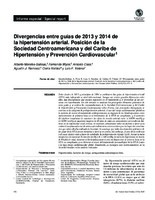Divergencias entre guías de 2013 y 2014 de la hipertensión arterial.: Posición de la Sociedad Centroamericana y del Caribe de Hipertensión y Prevención Cardiovascular¹
| dc.contributor.author | Morales-Salinas, Alberto | es_ES |
| dc.contributor.author | Wyss, Fernando | es_ES |
| dc.contributor.author | Coca, Antonio | es_ES |
| dc.contributor.author | Ramírez, Agustín J. | es_ES |
| dc.contributor.author | Valdez, Osiris | es_ES |
| dc.contributor.author | Valerio, Luis F. | es_ES |
| dc.date.accessioned | 2015 | |
| dc.date.available | 2015 | |
| dc.date.issued | 2015 | es_ES |
| dc.identifier.citation | Morales-Salinas, Alberto,Wyss, Fernando,Coca, Antonio,Ramírez, Agustín J.,Valdez, Osiris,Valerio, Luis F. (2015) Divergencias entre guías de 2013 y 2014 de la hipertensión arterial.: Posición de la Sociedad Centroamericana y del Caribe de Hipertensión y Prevención Cardiovascular¹. Rev Panam Salud Publica;37(3) 172-178,mar. 2015. Retrieved from http://www.scielosp.org/scielo.php?script=sci_arttext&pid=S1020-49892015000300007 | es_ES |
| dc.identifier.uri | http://www.scielosp.org/scielo.php?script=sci_arttext&pid=S1020-49892015000300007 | es_ES |
| dc.identifier.uri | https://iris.paho.org/handle/10665.2/9203 | |
| dc.format.extent | tab | es_ES |
| dc.relation.ispartofseries | Rev Panam Salud Publica;37(3),mar. 2015 | es_ES |
| dc.subject | Hipertensión | es_ES |
| dc.subject | Factores de Riesgo | es_ES |
| dc.subject | Antagonistas Adrenérgicos Beta | es_ES |
| dc.subject | Hypertension | es_ES |
| dc.subject | Risk factors | es_ES |
| dc.subject | Adrenergic beta-antagonists | es_ES |
| dc.title | Divergencias entre guías de 2013 y 2014 de la hipertensión arterial.: Posición de la Sociedad Centroamericana y del Caribe de Hipertensión y Prevención Cardiovascular¹ | es_ES |
| dc.type | Journal articles | en_US |
| dc.rights.holder | Pan American Health Organization | en_US |
| dc.description.notes | Entre finales de 2013 y principios de 2014 se publicaron las guías de hipertensión arterial (HTA) más influyentes a nivel internacional. Aunque no existen grandes diferencias entre ellas, hay discrepancias que pueden repercutir en el tratamiento y el pronóstico de las personas con hipertensión. En este artículo se analizan los principales elementos polémicos de estas guías y se emiten las recomendaciones de la Sociedad Centroamericana y del Caribe de Hipertensión y Prevención Cardiovascular sobre el tema. Las principales divergencias se centran en la categoría de prehipertensión arterial, el uso del riesgo cardiovascular global en la decisión de iniciar el tratamiento antihipertensivo, la vigencia de los betabloqueantes como medicamentos de primera línea en el tratamiento de la HTA no complicada, y el aumento del objetivo terapéutico de mantener las cifras de tensión arterial entre 140/90 mmHg y 150/90 mmHg en pacientes mayores de 60 años de edad, sin antecedentes personales de diabetes ni de enfermedad renal crónica. Se analizan críticamente todos los factores a favor y en contra de aceptar cada uno de estos cuatro elementos controvertidos y se incluyen los comentarios que sobre ellos ha realizado la Sociedad. Se concluye que todos los elementos polémicos de las guías de la HTA tienen elementos a favor y en contra. Sin embargo, el peso de la evidencia o el juicio clínico están a favor de subdividir la prehipertensión (Grado I y II), buscar la meta terapéutica de mantener la tensión sistólica de 140 mmHg en todos los hipertensos de menos de 80 años de edad, mantener a los betabloqueantes como medicamentos de primera línea en la HTA no complicada, y no demorar el inicio del tratamiento farmacológico de la HTA Grado I de bajo riesgo cardiovascular global. Finalmente, se incluyen siete recomendaciones de la Sociedad basadas en los análisis realizados.(AU) | es_ES |
| dc.description.notes | Between the end of 2013 and the beginning of 2014 the most internationally influential hypertension guidelines were published. Although there are no major differences between them, there are discrepancies that can have an impact on treatment and prognosis for individuals with hypertension. This article analyzes the main controversial elements in the guides and presents the recommendations of the Sociedad Centroamericana y del Caribe de Hipertensión y Prevención Cardiovascular (Caribbean Society for Hypertension and Cardiovascular Prevention). The main differences are found a) in the categorization of prehypertension, b) in the use of global cardiovascular risk in the decision to begin antihypertensive treatment, c) in the validity of beta-blockers as first-line drugs in treating uncomplicated hypertension, and d) the increase in the therapeutic goal of maintaining values between 140/90 and 150/90 mmHg in patients over 60 years of age with no history of diabetes or chronic kidney disease. All the factors in favor of and against accepting each of these four controversial criteria are analyzed critically and the observations made by the Society are included. The conclusion is that there are pros and cons for all controversial elements in the hypertension guides. However, the weight of the evidence and clinical judgment favor subdividing prehypertension into stages I and II, seeking a therapeutic goal of maintaining systolic blood pressure below 140 mmHg in all the hypertensive patients under 80 years of age, retaining beta-blockers as first-line drugs in uncomplicated hypertension, and not delaying the start of drug treatment for hypertension stage I with low global cardiovascular risk. Finally, seven recommendations by the Society based on the analysis are included.(AU) | en_US |
Files in this item
This item appears in the following Collection(s)
-
Pan American Journal of Public Health
Revista Panamericana de Salud Pública




